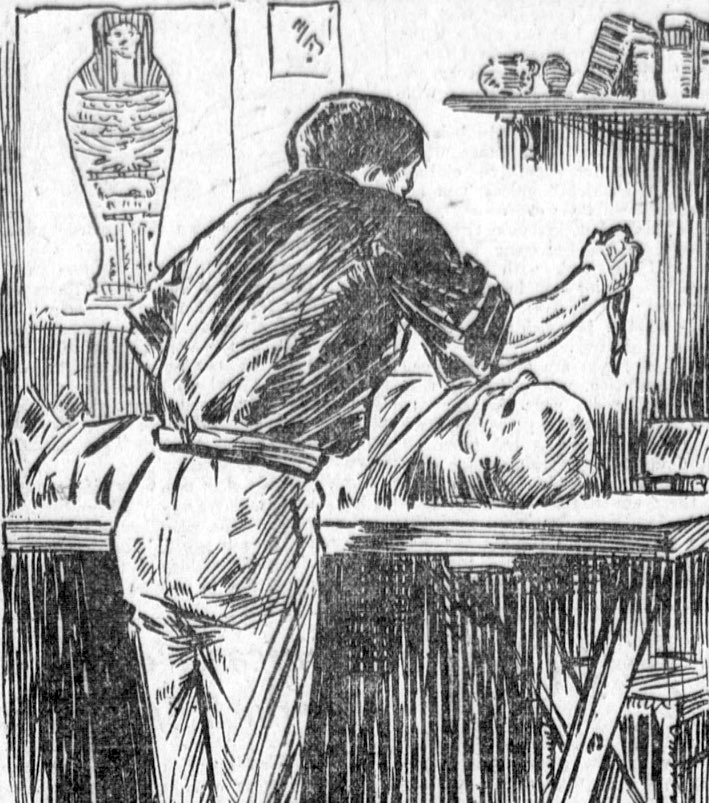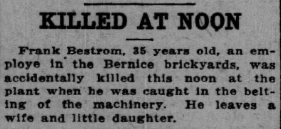
Everyone wants to have a mummy in their home, right? I actually like the idea of manufacturing fake mummies to sell off. They’d make great Halloween props or would be perfect for people who want to create a retro Egyptian room in their homes.

Egyptian Mummies Made While You Wait
After Having Made a Fortune in Fake Remains, the American Manufacturer Closes Business
THE mummy dealers of Egypt will have to scratch around for new specimens of “genuine Egyptian mummies, cheap at any figure,” for their American supply house has closed its doors and not another “mum” will be shipped from our shores, unless there are other unknown establishments carrying on this fake business.
It is history that we like to be fooled, but it grieves us to know that we have been taken in for over a quarter of a century by one of our own countrymen.
For twenty-seven years the manager and owner of the only known mummy factory on this or the other side of the water, has been turning out fake antiquities at the rate of several hundred dollars’ worth a day. From fifteen to eighteen “genuine Egyptian mummies” have been manufactured in this factory weekly and sold to collectors or shipped direct to Egypt or to other foreign museums.
When this enterprising dealer in antiquities, who for obvious reasons desires to withhold his name, opened his shop in Los Angeles, Cal., where he sold Indian war relics, foreign curios and genuine antiquities in the front room, which he manufactured in secret in the rear, he made a solemn vow that as soon as he had amassed enough money to allow him to live comfortably in honesty, he would close his fake shop and expose the business.
True to this vow made twenty-seven years ago on the 18th of last July, he now tells how his fellow countrymen traveled hundreds of miles and spent thousands of dollars to view awe inspiring, hair raising mysteriously preserved figures of the land of the Nile which had been manufactured within a stone’s throw of their own homes.
The First Fake
This manufacturer came to America when but a lad of 19 and he had a hard struggle for existence. While wandering around New York City in search of a job he strayed into an art museum, just as one of the attendants was dusting one of the mummy cases. The two got into an animated conversation regarding the genuineness of the carefully guarded mummy and the skeptical visitor declared that he could make a “stiff” which would fool even those who were up in “mummyology.” Hot words ensued and the attendant stalked away to other duties in indignation at the sacrilegious one who could point a finger of doubt at his precious charges and even suggest imitation.
Several days later that scoffer returned, carrying a mysterious long box. He beckoned the attendant to a quiet corner and undoing his package drew forth a much swathed figure which appeared to be a “gem” of a mummy. He enjoyed the rhapsodies of the attendant for several minutes, allowed him to examine the “antiquity” thoroughly, hinted at a rich uncle who was a collector when questioned how he came into possession of such a prize, and finally burst into a laugh as he unwound the swathings and exposed his trick — a cleverly made mummy.
This was the beginning of his establishment, which has grown to such importance that the news that it has closed its doors has thrown a score or more European antiquity dealers into a panic. Where are they going to get their new attractions for exhibition purposed; who now will supply them with bait for American gold? Not the man who twenty-seven years ago sold his first mummy in Buffalo and with the money received bought a through ticket to California. In Frisco he purchased some plaster, glue, paint, bamboo and other materials necessary for the successful manufacture of mummies, and then traveled on to Los Angeles, where the faking business could be conducted with less suspicion.
Here he rented the little shop which he has just closed and pretty soon curio seekers from all parts of the States and European visitors were hunting him up and bidding against each other for his “Alligator Boys,” Indian baskets, old pottery, ancient heathen charms, bits of valuable parchment and the like. Little by little his establishment grew and one morning nine months after he had taken down the shutters the first “genuine Egyptian mummy” appeared in his show window.
Required a Learned Assistant
From then on business was brisk. They young dealer was obliged to hire a learned college graduate to welcome visitors to the shop and talk understandingly upon the valuable relics carefully guarded therein and parted with reluctantly for a good round sum.
Visitors were encouraged to make themselves at home in that front room. They were permitted to wander at will among the “musty” dusty antiquities and to remain undisturbed as long as their interest held them there, but no one, not even the college graduate, who won the confidence of timid collectors by his learned discourse upon dead languages and ancient customs, was allowed to pass through the rear door of the shop into the apartments where the dealer spent so much time “opening valuable packages from foreign parts and tracing out the authenticity of their contents.” Shortly after the arrival of one of these mysterious packages there would appear in the show window a splendid specimen of something “antique.”
The packages in reality were materials for the work room. This work room was most simply equipped, containing a small book shelf upon which stood well thumbed volumes relating to all kinds of antiquities. On the walls were pinned photographs and prints of mummies, pottery and Indian relics and in the center of the room there stood a long deal table, with a tool box containing funnels, sieves, fine saws, “invisible” tacks, sponges and a tiny hammer or two.
Boxes containing various kinds of woods, clay, sand and yellowish powder stood about. Bundles of bamboo, rolls of absorbent cotton and of gauze, layers of tissue paper and come cotton material, the name of which the maker still keeps secret, were neatly placed upon another table, and close at hand were bits of cows’ horns.
Experts Received
This was the entire outfit of this factory where mummies were turned out while you wait and here venerable crumbling Egyptian princesses were so closely imitated that the fraud was not discovered even by experts.
The manufacture of a mummy is really the simplest task. The first thing considered is the backbone or “vertebral column.” This consists of a well planed and graded plank, pliable enough to be handled roughly without snapping and strong enough to withstand travel and examination. This backbone acts, of course, as a stay to the head, body and legs. To the divided ends, or the legs of this vertebral column, are nailed two short, shaped boards representing the feet.
This partial framework, or foundation, completed, the whole is put in a sack stuffed with a composition of clay and other material which, when a certain chemical is poured on, solidifies. This is moulded into the shape of a human form and made ready for ribs.
These ribs are the most delicate part of the entire construction of a “mum.” They must be of just the right size and placed in proper relation to each other. They are of carefully selected bamboo and are glued to the outside of the stuffed sack, or body of the figure. The frame work of the arms and fingers is formed in the same way, and then the entire body is covered with a thin but durable coat of plaster.
On top of this plaster is spread a coat of glue and a fluffy tissue pasted on; this is again covered with glue. The body at this stage is of a yellowish color, and in touch and appearance can scarcely be distinguished from a fresh human skeleton.
When the body is completed up to this point the head is put in position and covered with glue and tissue in the same way as the body. The eyeholes are painted dark brown inside and covered with a piece of this peculiar tissue. A small slit is made in the middle and the effect, even upon the most minute examination, is that of the sunken eyes of a real mummy.
A few hairs are next pasted on top of the skull and the teeth are made out of small pieces of cow’s horn spoken of. The head and neck with the exception of the face, which is left exposed, are wrapped with several layers of “crumbling” linens, as are the genuine “mums,” and these swathings cover the entire body in many folds, leaving exposed such spots as are desirable to show the “skin and bones” underneath.
When this point in the manufacturing is reached the form, which has already been dipped in dye, is once more doused quickly in the dyeing vat, this time with all its swathings on. Before it is perfectly dry the entire body is sprinkled with a gray dust or powder, which completely fills all holes and gives the finishing touch of “antiquity” to the product.
The mummy is now ready for exportation to some Egyptian crypt or to the halls of some famous museum, where it will be viewed with awe by thousands of visitors.
Source: Los Angeles Herald. Newspaper. September 30, 1906.

